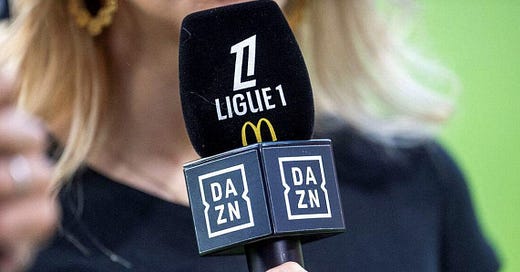A Turning Point in French Football's Broadcast Future
In the ever-evolving landscape of sports broadcasting, Ligue 1's decision to part ways with DAZN after just one season of a five-year contract is more than just a messy breakup
Haven't subscribed yet? Join our community of sports enthusiasts eager to broaden their understanding of global sports. Whether you're a student, professional, or business owner, our newsletter provides invaluable insights into the sports industry.
It all started with high hopes. In mid-2024, DAZN entered the French market aggressively, clinching rights to broadcast eight out of nine Ligue 1 matches each week, valued at €400 million annually. It was billed as a fresh chapter, one that promised innovation, global reach, and the revival of French football's commercial allure after the Mediapro and Amazon sagas. But behind the scenes, cracks appeared quickly: underwhelming subscriber numbers, strained club relations, and allegations of piracy left both sides increasingly frustrated.
By early 2025, the partnership had turned sour. DAZN, citing poor cooperation from the LFP and rampant piracy, withheld half of a €70 million payment. The LFP retaliated with legal action. Mediation followed, but only delayed the inevitable. Eventually, the two sides struck a deal: DAZN would walk away, paying €100 million in exit fees and the remaining €140 million owed. For DAZN, the quick exit was damage control. For the LFP, it was a chance to reset—but not without consequences.
Perhaps the most daring twist is the LFP’s decision to take broadcasting into its own hands through a Direct-to-Consumer (DTC) platform, something no other top-five European league has dared to do. It’s an audacious play for autonomy and profit, but also a leap into uncharted waters. With only a few months before the 2025/26 season begins, there’s no platform built, no marketing infrastructure in place, and few confirmed partners. In media terms, it’s a race against the clock with clubs caught in the middle.
Without a concrete broadcasting framework, French clubs are now staring at a major budgeting nightmare. The DNCG (France’s football financial watchdog) has even advised teams to exclude TV rights from next season’s revenue forecasts. That’s staggering, especially when you consider that media rights form a lion’s share of income for many clubs. A potential €1.2 billion black hole looms. Sponsors and investors are also left jittery, unsure whether the visibility they signed up for will exist come August.
For sponsors, visibility is everything. Uncertainty over how, where, or even if matches will be broadcast could dilute brand value and deter potential partners. Unlike traditional broadcasters, a fledgling DTC service lacks the established audience pipelines that sponsors rely on. This threatens to shrink commercial revenue not just for the LFP, but across the board – from shirt sponsors to stadium naming rights. It’s a domino effect waiting to tumble if not quickly addressed.
DAZN’s failure to gain traction in France isn’t purely down to mismanagement, it’s in fact a lesson in product-market fit. The platform reportedly attracted just 500,000 subscribers, far below its 1.5 million breakeven point. France’s media consumption habits, saturated subscription landscape, and fan reluctance to abandon Canal+ created a hostile environment. The lesson that could be learnt here is – Even with premium content, platforms must localise deeply and market smarter, not just louder.
The LFP has long tried to peg Ligue 1 alongside the Premier League and La Liga in media value. But the consistent overestimation of its product, first with Mediapro, then DAZN which has left a trail of broken contracts and bruised credibility. This latest fallout is another symptom of that ambition-meets-reality mismatch. If the league doesn’t recalibrate its expectations, it risks alienating future partners entirely.
Still, a DTC platform does offer a glimmer of innovation. A well-executed service could unify fragmented coverage, offer exclusive content, and let fans access every match in one place, which is something no French broadcaster currently does. If done right, it could lead to deeper fan engagement, better data collection, and greater control over monetisation. It’s a marketer’s dream but only if the user experience is seamless and the pricing is attractive.
LFP’s best chance for making its channel work may lie in strategic alliances. DAZN has offered to build and operate the platform, while BeIN Sports and even Canal+ have reportedly reopened discussions. A hybrid approach where the LFP controls editorial and branding, while a partner handles infrastructure, could balance risk and reach. But hesitation and ego must give way to pragmatism if this channel is to launch on time and scale.
So, the major question that everyone would have is whether this will work? It can, but the margin for error is razor-thin. The LFP has chosen a bold path that, if successful, could redefine how football is consumed in France and perhaps inspire others across Europe. But if it flops, it could send French football back years, deepening financial woes and damaging brand trust. As it stands, the league is teetering on the edge of a revolution or a revenue cliff.
Some housekeeping stuff
If you can’t find the newsletter, check your Spam folder or Promotions tab, and move this email to your primary inbox. Make sure to mark this email address as ‘not spam’.
Today’s recommended podcast…
Following Wrexham AFC's latest promotion at the weekend, CEO Michael Williamson joins Leaders Editorial Director James Emmett and Content Director David Cushnan.
He lifts the lid on a memorable day - and night - at the Racecourse Ground, as Wrexham secured its third successive promotion, as well as early planning for life in the second-tier Championship next season.
Williamson also discusses the redevelopment of the Racecourse Ground, rising expectations, English football's new independent regulator and, a year into his CEO role, how he came to work for owners Ryan Reynolds and Rob McElhenney.





